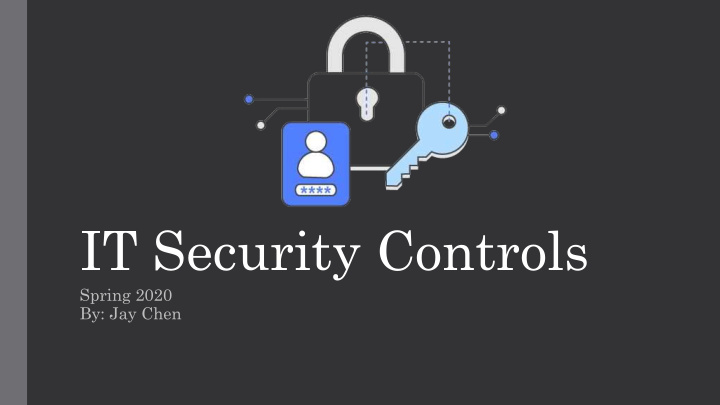



IT Security Controls Spring 2020 By: Jay Chen
What are Security Controls? • A safeguard or countermeasure for an information system or an organization designed to protect confidentiality, integrity, and availability of its information and to meet a set of defined security requirements • Types of Controls Preventive Controls Procedural Controls • • Password lockout after 5 Security awareness training, failed attempts incident response plan Detective Controls Technical Controls • • Intrusion Detection System Anti-virus, firewall, user (IDS) Alerting on Attacks authentication Corrective Controls Legal Controls • • Patch management, Incident Policies Response Team Physical Controls • Locks, fences, doors
Why do we need IT Security Controls? • Design a cybersecurity program ● Protect critical infrastructure ● “Cyber threats cannot be eliminated but they can be managed.” ● Maintain CIA • Prevent security incidents ● “Global Average Cost of a data breach is $3.86 million” ● “Average cost for each stolen record is $148 per record” • Laws and regulations (HIPAA, PCI, GDPR) https://securitytoday.com/articles/2018/07/17/the-average-cost-of-a-data-breach.aspx
Regulations and Industry Standards • HIPAA (Healthcare) • FERPA (Education) • FISMA (Government) • State Laws – NY DFS (Financial) • International Laws – GDPR (EU) • Industry Standards – PCI DSS (Payment Processors)
What is risk? • The potential of losing something of value • Risk = Likelihood X Impact ● Impact: How could the event it affect our business? ● Likelihood: What is the probability of the event?
Risk and Controls Controls are implemented to help manage and mitigate risk Types of IT Risk • Lack of IT oversight by management • Lack of IT policies for security and operations • Lack of IT infrastructure inventory for software and hardware • Lack of incident response plan • Lack of monitoring of third party service provider
So how do we ensure we have the correct IT controls?
By using frameworks
What is a security framework? • A framework consisting of policies, procedures, and processes that define how information is managed in a business, to lower risk and vulnerability • A framework is not: ● A regulation ● A legislation • However, a framework is a best practice
List of Security Frameworks • COBIT ● Created by ISACA ● Risk Management Framework • ISO 27000 Series ● Created by International Organization for Standardization (ISO) ● Information Security Standards • NIST SP 800 Series ( https://csrc.nist.gov/publications/sp800) ● Created by National Institute of Standards and Technology ● Technology/Computer Security Frameworks and Guidelines ● 100+ SP Series Publications ● Highlights ● 800-53 (Security and Privacy Controls for Information Systems and Organizations) 494 Pages ● 800-37 (Risk Management Framework) ● 800-12 (An Introduction to Information Security) ● 800-121 (Guide to Bluetooth Security) ● 800-184 (Guide for Cybersecurity Event Recovery) ● 800-115 (Technical Guide to Information Security Testing and Assesment)
List of Security Frameworks • PTES (Penetration Testing Execution Standard) ● Created by a group of information security practitioners ● http://www.pentest-standard.org/index.php/Main_Page • NIST Cybersecurity Framework (NIST CSF) ● Created by National Institute of Standards and Technology ● A shorten 800-53 for private sector businesses • HiTrust CSF (Health Information Trust Alliance Common Security Framework) ● Cybersecurity Framework for healthcare industry (HIPAA) • CIS Top 20 ● Created by Center for Internet Security ● Top 20 Security Controls
CIS Top 20 • Center for Internet Security Top 20 Controls • CIS Top 20 Critical Security Controls is a prioritized set of best practices created to stop the most pervasive and dangerous threats. • 3 Tier Implementation Level • CIS Category ● Basic CIS Controls ● Foundational CIS Controls ● Organizational CIS Controls
Basic CIS Controls (Technology)
Foundational CIS Controls (Technology)
Organizational CIS Controls (People & Process)
Analyzing CIS Controls
CIS Control 1 Implementation Guide
What is NIST CSF? • NIST Cybersecurity Framework • Created by the National Institute of Standards and Technology (NIST) • The NIST cybersecurity framework separate into five cores ● Identify ● Detect ● Protect ● Response ● Recover • These five cores represents industry standards, guidelines, and practices for cybersecurity activities across an organization.
NIST Cybersecurity Framework
Identify • Develop an organizational understanding to manage cybersecurity risk to systems, people, assets, data, and capabilities.
Protect • Develop and implement appropriate safeguards to ensure delivery of critical services.
Detect • Develop and implement appropriate activities to identify the occurrence of a cybersecurity event.
Respond • Develop and implement appropriate activities to take action regarding a detected cybersecurity incident.
Recover • Develop and implement appropriate activities to maintain plans for resilience and to restore any capabilities or services that were impaired due to a cybersecurity incident.
Control Breakdown Functions # of Subcategory (Controls) Identify 29 Protect 39 Detect 18 Respond 16 Recover 6 Total 108
NIST CSF Structure (Categories)
NIST CSF Structure (Subcategories)
NIST CSF Structure
NIST CSF Structure/ Risk Management
NIST CSF (First Two Controls)
NIST CSF Mapping
CIS Control Mapping
Risk Assessment Process
The End • Questions?
Recommend
More recommend